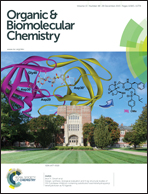A computational study of the chlorination and hydroxylation of amines by hypochlorous acid†
Abstract
The reactions of hypochlorous acid (HOCl) with ammonia, (di)methylamine, and heterocyclic amines have been studied computationally using double-hybrid DFT methods (B2PLYP-D and BK-PLYP) and a G3B3 composite scheme. In the gas phase the calculated energy barriers for N- and/or C-hydroxylation are ca. 100 kJ mol−1 lower than the barrier for N-chlorination of amines. In the model solvent, however, the latter process becomes kinetically more favored. The explicit solvent effects are crucial for determination of the reaction mechanism. The N-chlorination is extremely susceptible to the presence of explicit water molecules, while no beneficial solvation effect has been found for the N- or C-hydroxylation of amines. The origin of the observed solvent effects arises from differential solvation of the respective transition states for chlorine- and oxygen-transfers, respectively. The nature of solvation of the transition state structures has been explored in more detail by classical molecular dynamics (MD) simulation. In agreement with the quantum mechanical approach, the most stable structural motif, which includes the amine, HOCl, and two reactive waters, has been identified during the MD simulation. The inclusion of 5 or 6 explicit water molecules is required to reproduce the experimental barriers for HOCl-induced formation of N-chloramines in an aqueous environment.


 Please wait while we load your content...
Please wait while we load your content...